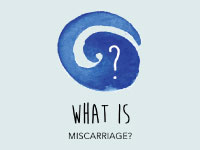Early pregnancy loss is such an individual experience, that the treatment and procedures around it are different for everybody.
If you’ve been for an ultrasound and it’s been determined that you have lost your baby, in general the treatment and procedures available to you are:
(a) wait to miscarry naturally
(b) elect to have a ‘dilation and curettage’ otherwise known as a D&C or
(c) take a tablet to induce miscarriage.
For some women, it’s not until they start bleeding that they know anything has happened to their baby, and you may have a complete miscarriage straight away.
You can be guided by your doctor or specialist as to the most appropriate way to progress for your individual situation. Generally, if it is a fairly early loss, waiting for the pregnancy to miscarry naturally will be the most common course of action. For later first trimester losses or if a missed miscarriage has occurred, a D&C is usually recommended.
Some women may have personal preferences around which miscarriage treatment and procedures feels right for them. Some believe that letting the body take its natural course is best; others feel that a natural miscarriage would be too painful or traumatic and they’d rather have the pregnancy surgically removed so it’s over more quickly.
Whichever option you choose is going to impact you emotionally as well as physically. Please make sure you have your partner or a friend with you for support.

Expectant Management – Natural Miscarriage
One of the hardest parts about waiting for a pregnancy to miscarry naturally, is not knowing when it will happen… a few days or a few weeks?
Generally, once your HCG and progesterone levels begin to drop, you will start spotting or cramping and this will escalate fairly quickly to heavy bleeding. The cramps may worsen and feel like bad period pain or contractions, as your body works to expel the pregnancy tissue.
The bleeding will likely get fairly heavy and depending on how far along you are, you may also pass large clots of tissue. If you have spoken to your OB or treating doctor about having the tissue tested for abnormalities, you may want to try to capture it in a jar or plastic bag – though this can obviously be quite traumatic and practically speaking, may be difficult to do. After about 24 hours or so, your cramping should subside and blood flow will reduce.
You may continue to spot for up to a week or two after the miscarriage, but if any of the following occurs, please call your doctor or go to the hospital ASAP:
- Severe abdominal pain or excruciating cramps that are not subsiding
- You develop a temperature
- An increase in bleeding and/or bleeding that is soaking a pad every few hours for more than 2-3 days
- If bleeding lasts longer than 2 weeks
- If bleeding stop/starts for longer than 2-3 weeks
You should have a normal period around 4-6 weeks after the miscarriage. Remember, you can fall pregnant during the first cycle after a miscarriage, however most doctors recommend you wait one full cycle before trying again.
The potential trauma around miscarrying at home should not be underestimated. While for the majority it will be no more than cramps and heavy bleeding, for others being faced with the ’tissue’ that was their baby, or being able to see a partially formed fetus on a bathroom floor can be utterly distressing. Please be kind to yourself and reach out for support if you need it.

Surgical Management – Dilation & Curettage (D&C)
If you're a bit further along in your pregnancy, ie 8+ weeks, or if you’ve had a missed miscarriage whereby the baby has already died but your body has not recognised it, a D&C is usually the most common course of treatment.
It is a fairly simple day surgery procedure that only takes about 15-20 minutes all up, though you will be required at the hospital for 4-5 hours, including time in recovery. The D&C is performed under a light general anaesthetic, and the doctor will remove the contents of your uterus while also scraping away the uterine lining. Your doctor will be able to send the tissue for testing if you wish.
Following the D&C, you should have some light bleeding for up to 2 weeks, though it may resolve sooner. If you need to take paracetamol for cramps, do so, but any cramping should not last longer than 24 hours. You should avoid using tampons or having intercourse for at least 2-4 weeks after the D&C to prevent any infection from occurring.
Although it is a simple and fairly common procedure, a D&C is not without risks. These risks, while unlikely, include:
- An adverse reaction to anaesthetic
- Scarring of the uterus
- Perforation of the uterus
- Infection in the uterus

Medical Management – Inducing Miscarriage
If you would prefer not to have a D&C, but also do not want to wait with uncertainty for your miscarriage to occur naturally, you can opt to take a medication which will induce the body to expel the pregnancy.
The most commonly used medication is called Misoprostol and it has been proven to be effective for approximately 80% of women whose miscarriages occurs before 9 weeks. It can be administered vaginally or orally, taking one dose per day for two consecutive days.
Cramping and bleeding usually begins 2-4 hours after the first dose and will last up to 24-72 hours. Some people may experience nausea, fever, vomiting and diarrhoea but for most people, the process will be similar to that of an expectant (natural) miscarriage.
It is very important to take the second dose of the medication as it helps to ensure the uterus is completely emptied. A small percentage of women may experience excessive pain or bleeding, in which case you should alert your doctor or visit your nearest emergency department.
As with a natural miscarriage, the process of expelling your baby can be quite distressing. Please reach out for support and reassurance if you need it. We are here for you.
For more information, please discuss with your treating doctor.

What is Miscarriage?
Sadly, miscarriages are a common occurrence with up to one in five pregnancies ending before 20 week's gestation.
Read more
Types of Miscarriage
There are several different types of miscarriage. Depending on your symptoms and the stage of your pregnancy, your doctor will diagnose one of the following
Read more